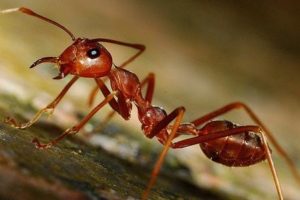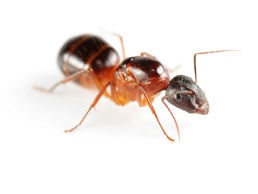Ant Removal & Info
Ants form colonies that range in size from a few dozen predatory individuals living in small natural cavities to highly organised colonies that may occupy large territories and consist of millions of individuals. Larger colonies consist of various castes of sterile, wingless females, most of which are workers (ergates), as well as soldiers (dinergates) and other specialised groups. Nearly all ant colonies also have some fertile males called “drones” (aner) and one or more fertile females called “queens“. The colonies are described as superorganisms because the ants appear to operate as a unified entity, collectively working together to support the colony.
Biology & Behavior
Outdoors, nesting activity can result in excavated soil being deposited in gardens and on brickwork. In most cases this causes little property damage but some species, especially species of Aphaenogaster, can form large numbers of chambers close to the surface. These chambers can cause soil to become soft and uneven, causing serious problems when found in golf courses or some types of pastures or crops. A few species will occasionally attack electrical wiring, apparently being attracted to either the insulation or the magnetic fields produced by the wires. In these situations extensive damage has occurred.
Tracks
Some ants build nests in walls and foundations, or indoors in potted plants, enclosed areas, and even in cavities in toilets and sinks. In almost all cases nests are limited to pre-existing cavities or spaces between objects or in rotten wood and seldom will ants attack solid structures. Thus they generally will not cause structural damage to buildings but will take advantage of existing deterioration.
Damage
Ants cause problems primarily when they forage in buildings for food or water and when they construct nests in buildings and gardens. When searching for food, they can be attracted to a wide range of products with different species preferring sweets, meats, fats or oils. They will also search indoors for water during dry periods. When desirable items are found many species will recruit fellow nest mates to help gather the food and return it to the nest. This can result in large numbers of ants appearing over a short period of time. Ants can be a nuisance when attempts are made to establish plants through direct seeding. Workers will forage for the newly planted seeds, removing them to their nests and causing reduced germination.
Pictures
Commonly ASKED QUESTIONS?
What do you do with trapped animals?
That answer depends on the state in which you live. Each state has their own laws that dictate what we must do when it comes to controlling wildlife on your property. In some states, we can trap, transfer and release the animals. In some states we can trap the animals, but we can only release them back onto your own property. If you don’t want the animal released on your property, it must be humanely euthanized. Sometimes we don’t even need to trap the animal and a simple exclusion device (one-way door) can be installed to allow the animal to exit your home and be locked out.
How much does it cost to remove an animal?
There are a number of factors that determine pricing; location of the animal (i.e. – chimney, attic, crawl, wall void, living area), condition of the animal (i.e. – sick, aggressive, dead), location and condition of the property and time of year (i.e. – weather condition, offspring present?). Generally speaking, pricing will vary by location and species for just the animal removal and that pricing usually does not include the entry repair.
I think I have birds in my chimney, can you get them out?
The answer to that question is most likely “Yes”, but are you sure what you’re hearing is birds? Raccoons easily invade chimneys and they have their litters on the smoke shelf of fireplaces. The sounds baby raccoons make are often mistaken for birds in chimneys and removal can be difficult. The only birds that nest in chimneys are chimney swifts and they’re federally protected, so removal can’t be performed, but exclusion can be – once they depart. If you have a pre-fabricated chimney and birds fall between the cooling tubes, removal is nearly impossible.
How soon can you get here?
Office hours vary from franchise to franchise, but generally speaking, office hours are 8am – 6pm M-F and 9am – 3pm on Saturdays.
Clients Testimonials
OUR EXPERTS WILL SOLVE THEM IN NO TIME.
Have Any Pest Problems?
Navigations
Contact Information

At Critter Removers we're committed to providing you with the highest level of services and solutions to best fit your pest or critter control needs.

